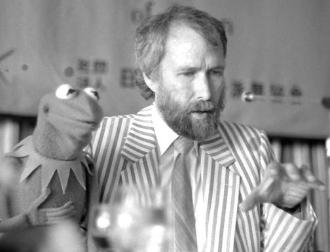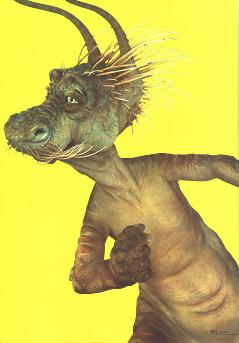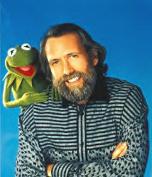Originally published in Silver Kris magazine, September 2004.
Monster Dreams
The Jim Henson Company is bringing its grandest vision to life, and
transforming the animation industry in the process. Will Kern speaks
with Lisa Henson, its dynamic Co-CEO.
The sand fairy from E. Nesbit’s classic Five
Children and It likes to play tricks on little
children, granting them wishes that go horribly
and hilariously wrong. It is devious,
mischievous, and somewhat wicked. A
monster. As a child, Lisa Henson was hooked.
“I loved It when I was a kid,” says the stylish film
producer in her cozy Hollywood office. Making
the book into a movie was “one of those ideas I
carried around since I was literally ten years
old.” Now that she Co-Chair and Co-CEO of
The Jim Henson Company, along with her
brother Brian, her childhood dreams are
becoming realities. The movie, starring
Kenneth Branaugh, is slated for release later
this year.
Which begs the question: What kind of kid
thinks, “Hmm. This book would make a good
movie,” and then goes on to make it as an
adult?
A kid with dreaming in her veins.
She comes by it honestly. Her father, the late
Jim Henson, was a true visionary who
revolutionized the art of puppetry when he
created The Muppets back in the 1950s. The
brand stands today as one of the most
recognizable ever.
In the 1970s, The Muppet Show was the most
widely watched series in television history. All
three major US networks passed on it before it
found a home with producer Lew Grade in the
UK. It sold incredibly well internationally,
appearing in over 200 countries, and went from
a show that had trouble getting guest stars its
first season to being “everywhere in the world,
virtually,” says Ms. Henson, attracting a diverse
list of the day’s hottest celebrities, including
Elton John, Alice Cooper, Gladys Knight, and
Roy Rogers and Dale Evans.
Legend has it that, as a high school kid, Jim
Henson created Kermit the Frog out of his
mother’s old green coat and a ping-pong ball.
Now, a generation later, the company he
founded uses cutting edge technology to
create science fiction, fantasy, and children’s
entertainment, plus a variety other media
projects.
JHC and the Academy Award winning Jim
Henson's Creature Shop are transforming the
animation industry. The new Henson Digital
Performance System (HDPS) brings a whole
new meaning to cinematic computing (see
sidebar). One performer can control hundreds
of character movements with just two hands.
Puppets and GI characters can perform subtle
facial expressions like a blink or a muscle twitch
in real time; with HDPS, five minutes of digital
animation can be completed in five minutes, as
opposed to months.
JHC produces film and television, and Jim
Henson's Creature Shop creates not just visual
effects for commercials and feature films, but a
whole menagerie of creatures from the ultra-
realistic. The Creature Shop created the
wonderful talking pig in Babe (and won an
Oscar for it), the ape in George of the Jungle
and the huge robot in Lost in Space and
recently did some of the special effects in
Around the World in 80 Days. “We’ll build
monsters or anything else,” says Henson. The
focus is not jut creating these monsters but
bringing them to life as well and giving them
character and personality.
As a child, Henson envisioned her father’s
company would build the sand fairy for her film
version of Five Children and It, and she always
dreamed it would be a Muppet. The end result
is much better than what she imagined. When
talking about her prized monster, she positively
beams. “He’s a wonderful Creature Shop
creation,” she says, and adds the work on It is
probably the finest they’ve done as a company.
But it isn’t just dreams that have taken the
company where it is. There’s been a lot of
hard work, and keen business sense too. In
the 1970s, the eldest of Jim Henson’s children
started out as a JHC intern. “I worked
summers, I painted. I made coffee for
everybody on set.” She graduated with a
degree in folklore and mythology in 1983, then
came back to Los Angeles and worked as a
Production Executive with Warner Bros. Ten
years later she became President of Columbia
Pictures, and left in 1997 to start Manifest Film
Company with producer Janet Yang.
Deep down, there were things she wanted to
do with JHC, projects she wanted to see get
made, and she had never officially produced
with her father’s company. So she made the
switch in 2002.
At JHC, she is in charge of strategic and
creative direction and oversees all television
and feature film production. One of the
company’s recent releases is Good Boy!, a live
action family film distributed by MGM, that Ms.
Henson Executive Produced. The film was one
of MGM’s most profitable releases in 2003.
Henson and brother Brian run JHC and are on
the board of directors with siblings Cheryl,
Heather, and John (that’s another reason the
Nesbit book was so near and dear to her heart.
five Henson children. Five Children and It.),
along with former CEO Charles Rivkin.
The five Hensons work well as a team. That’s
one big secret to success. She cites the re-
acquisition of JHC from the troubled German
media corporation EM.TV as a prime example.
“We did it secretly, and in three weeks. There
are a lot of levels to something like that, but it
all got done in just days.”
Munich-based EM.TV bought The Jim Henson
Company in February 2000 for $680 million in
cash and stock. Three years later, on the
brink of financial ruin, the company sold it back
to the Henson family in May 2003 for $84
million.
JHC then turned around and sold The
Muppets and Bear in the Big Blue House
franchises to the Walt Disney Company for
somewhere between $45 and $60 million. Jim
Henson was set to sell his company to Disney
in 1990, but he died on the day the deal was
supposed to go through, which threw the
transaction into turmoil. He courted Disney
because he wanted his characters to be under
the umbrella of a well-heeled corporate entity
where they could receive the kind of
distribution and marketing performance that a
smaller company like his own could not
provide. The family was happy with his wish
was finally realized.
What’s in the future at JHC? Plenty. Ms.
Henson is producing MirrorMask, a fantasy
feature film written by best-selling British author
Neil Gaiman and directed by multimedia artist
Dave McKean; and Farscape: The
Peacekeeper Wars, a four-hour miniseries that
concludes the popular science fiction television
drama, directed by brother Brian, that’s due to
hit US TV screens next month.
Jim Henson’s company has come a long way
from a green coat and a ping-pong ball. His
daughter Lisa Henson and her siblings are
steering it in a direction their old pop would be
proud of, toward a future, she says, that is
about “combining technology with puppetry to
design and develop characters, to create
quality TV and movie concepts and do
something amazing.” She is continuing the
tradition her father started 50 years ago, of
creativity, good storytelling, and technological
innovation.
And big dreams.

Madam CEO. Lisa Henson, Co-Chief Executive
Officer of The Jim Henson Company, in her
Hollywood office.
Two legends. Jim Henson and Kermit the Frog at
the Foreign Correspondents Club in Tokyo, Japan,
in August, 1986. The two were in town to promote
Henson's film Labyrinth and the Japanese version
of Fraggle Rock.
It.
WHAT'S THE BIG DEAL ABOUT HDPS?

So what’s new – computer generated
(CG) animation has been around for a while,
hasn’t it? But at The Jim Henson Company,
they’re giving animation a whole new
dimension. What’s amazing about the
Henson Digital Performance System’s
animatronics is not just how it’s done but
what it is able to accomplish.
The process of animation has always been
a painstaking one. In the old days, several
minutes of animation used to take from
weeks to months to complete because
animators had to draw characters frame-by-
frame, 24 frames per second of film. Even
the keyframe process, used in computer
generated animation like Pixar’s Toy Story,
also took many moons. HDPS hopes to
create 10 minutes of digital animation in 10
minutes – this is nothing short of
staggering!
At JHC, they are implementing a completely
different system. Their process of animation
now is “much closer to live action
filmmaking,” explains Lisa Henson. “The
talent is very different. We use live action
directors instead of animators, and they’re
directing puppeteers as they would actors in
a live-action film, getting as many takes as
they want and picking the best.”
HDPS works like this. A computer
generated (CG) character is performed in
real time by a puppeteer who manipulates
the system. His right hand goes into a
metallic glove-like contraption that controls
the character’s mouth. His left hand is on a
joystick that controls the character’s facial
features and head and body movements.
He has a computer screen in front of him so
he can watch his character as he controls it
and a microphone headset to record his
voice as he works the character’s mouth.
So when his hand makes the mouth move, it
moves on screen. When he wants to raise
an eyebrow, he does so with one of many
servos on the joystick.
It is high tech, but paradoxically it removes
the technology from the creative process so
a director can direct a puppeteer, and the
puppeteer can give a performance as an
animated character.
[early on] and he saw it as a natural
outgrowth of puppetry. Puppeteering CG
characters was something he wanted to do
[early on] and he saw it as a natural
outgrowth of puppetry. In his last film,
Muppet*Vision 3-D, (playing at Disney-MGM
Studios in Orlando and Disney’s California
Adventure in Anaheim) he had a
puppeteered CG character in it called
Waldo. So he actually did accomplish it with
this one character in 1990.”
An artist truly ahead of his time.
So who came up
with this? “I would
say Jim Henson
did because it was
all in his head as
a fully formed
idea,” she says.
Puppeteering CG
characters was
something he
wanted to do




